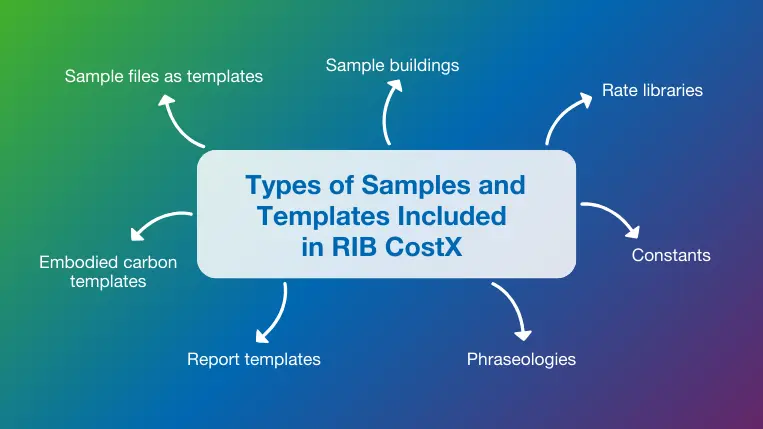11 mins read
The Ultimate Guide to Construction Estimate Templates: Save Time & Avoid Errors

Traditionally, the construction cost estimation process was done manually, leading to errors, rework, and projects that did not meet profitability goals. Today, the situation is different, as companies support themselves with professional estimating solutions that offer innovative features to skyrocket the accuracy and speed of the process. One of those features is intelligent templates. These pre-formatted documents provide a structured way to approach the estimating process, cutting hours of work and ensuring all stakeholders are on the same page.
This blog explores the value of construction estimate templates and how they can be managed using professional construction cost estimation software.
What are Construction Estimate Templates?
Construction cost estimate templates are pre-formatted documents that construction professionals use to calculate and present a project’s potential costs. They structure quantities, labor rates, materials, and more to increase estimating efficiency, accuracy, and speed.
While these documents provide an organized outline of all the information necessary to estimate the costs of a project, it is essential to understand its components to truly extract maximum potential. An effective estimate should include:
- Project’s key information, including the start and end dates, client name, scope of work, and any other valuable data.
- General descriptions of all the jobs to be completed to understand the requirements of each. This is usually called a work breakdown structure (WBS).
- Details of direct costs (labor, materials, equipment, etc.) and indirect costs (security, utilities, legal fees, administrative costs, etc.)
- Profit and overheads. Overheads include office administration and rent, insurance, licenses, etc.
- Construction contingencies are also included in estimates to account for any unexpected costs during the project. They usually account for 5-10% of the total budget.
- The “grand total” includes all indirect and direct costs, contingencies, allowables, and taxes.
- In some cases, construction value engineering suggestions, such as alternative materials or building methods, might be added to the estimates as strategies to reduce costs while maintaining quality.
Who Uses Cost Estimate Templates?
Many stakeholders use cost estimate templates throughout a project to understand the resource and financial requirements. However, they are generally the responsibility of the construction estimator or the quantity surveyor.
What are the Benefits of Using Estimating Templates?
Manually generating estimates is a time-consuming task that can lead to version control issues as the project evolves, and changes come up. Professional construction estimate templates provide a standardized and organized way to break down and estimate project costs efficiently and professionally. Other fundamental benefits include:
- Increased accuracy: Professional construction estimate templates ensure that all project details are accurately and precisely documented for error-free budgeting and planning.
- Enhanced professionalism: A well-structured, error-free contractor estimate template gives your company a professional appearance in the client’s eyes, improving your reputation and giving you a competitive advantage.
- Time savings: Templates eliminate the need to manually generate estimates from scratch. The data from previous projects can be reused to speed up the process, allowing teams to focus on analyzing costs and finding cost-effective solutions instead of formatting documents.
- Effective collaboration: These powerful tools facilitate communication and collaboration in construction projects by offering a standardized format, language, and terminology, making meetings and reviews more efficient.
- Reduced errors and omissions: Pre-set templates include all items missing from an estimating process, including contingency costs or indirect expenses—professional estimating software highlights when a template is missing information, ensuring error-free and complete estimates.
RIB CostX Software: Professional Construction Estimate Templates
RIB CostX is powerful estimating, BIM takeoff, and reporting software that connects design drawings with estimates for error-free results. Additional functionalities such as revision tracking, subcontractor comparison, embodied carbon calculations, and enhanced collaboration ensure costs and quantities are accurately and efficiently calculated for sustainable and profitable projects.
The software offers a range of templates and samples to help you get the most out of your estimating process. Templates are exclusively available for CostX users on the TechWeb interface, where filters can be added for region, format, language, and template type to make searching for the perfect template easier. The selected document can be easily downloaded from TechWeb, imported into RIB CostX, and attached to an existing or new project.
Types of Samples and Templates Included in RIB CostX

Sample files as templates: RIB CostX users can access several sample files that can be used as starting points to create customized templates that meet specific project needs. Sample files are invaluable tools for better understanding CostX’s features and functionalities. They are automatically added to the desktop when the software is installed and can also be accessed online.
Sample buildings: Sample buildings in RIB CostX are pre-configured estimating files that include dimension groups, folders, subfolders, live-linked workbooks, and drawings. They help save time in estimating by providing a ready-made structure that can be easily adapted to meet specific project requirements and quantities while maintaining the same logic as the original template.
Rate libraries: These samples list unit rates for materials, labor, and services used in construction projects. They are usually region-specific and are integrated into the workbook system from RIB CostX, allowing estimators to live-link rates to quantities.
Constants: These templates are especially valuable for estimating structural materials. They offer predefined values for engineering and quantity calculations, such as the weight per meter of steel beams or the surface area of specific components.
Phraseologies: Phraseologies refer to a specific standardized language used to communicate information within the estimates. It involves using precise terms and conventions to ensure everyone understands the estimating data. They are beneficial when estimates must adhere to a specific method of measurement. In CostX, you can easily drag phraseologies into the workbook column to create useful text for item descriptions and/or headings.
Report templates: CostX allows users to output estimate data into printable or exportable report templates. These templates can be customized to include priced or unpriced content and tailored by workbook level. They are ideal for client presentations, bid submissions, and internal reviews. Some of the report templates included in the software are rate buildup report, quantity buildup report, and estimate report, among others.
Embodied carbon templates: With sustainability being a major priority for companies today, RIB CostX offers robust sample buildings and rate libraries that allow users to track carbon emissions alongside costs; imported libraries for stages A1-A3 (material production) and A4-A5 (construction) pull embodied carbon values that are live-linked to estimates.
Final Thoughts
Accuracy, speed, and collaboration have become fundamental to successful and competitive construction estimates. Professional templates can significantly reduce the time it takes to generate cost estimates while mitigating the risk of errors and omissions that can affect a project’s profitability.
RIB CostX is powerful estimating and BIM takeoff software offering a robust library of templates and samples to enhance estimates. BIM-powered features allow for smarter, data-driven processes and improved collaboration that can skyrocket a project’s success.
If you want to join the thousands of companies benefiting from fast, precise, and collaborative estimates, get your free demo for RIB CostX today!

Most Recent
11 mins read
11 mins read
10 mins read
10 mins read
Blog Categories

Ebook











